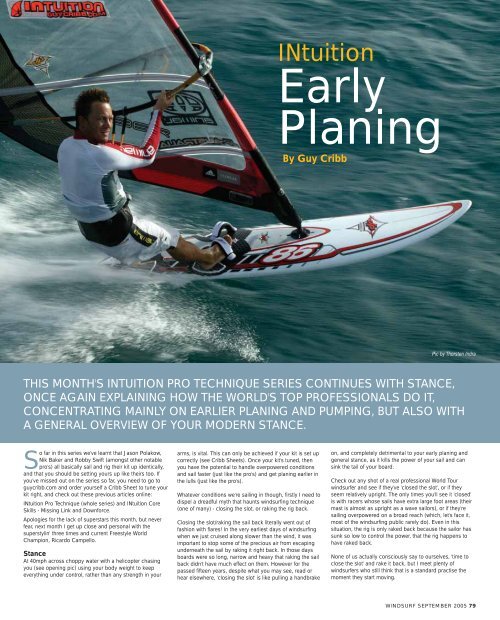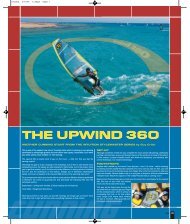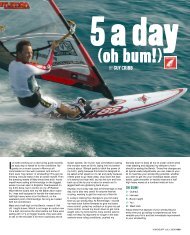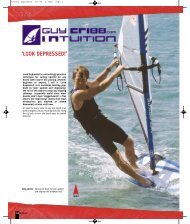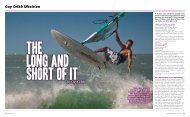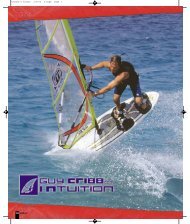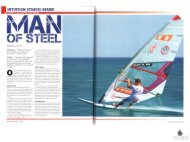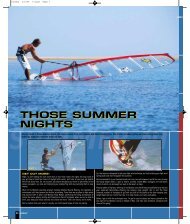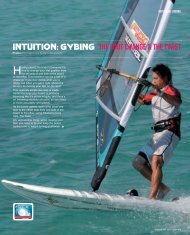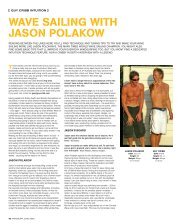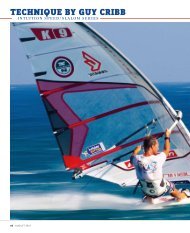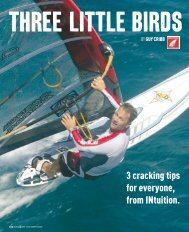Early Planing - Guy Cribb
Early Planing - Guy Cribb
Early Planing - Guy Cribb
You also want an ePaper? Increase the reach of your titles
YUMPU automatically turns print PDFs into web optimized ePapers that Google loves.
o far in this series we've learnt that Jason Polakow,<br />
Nik Baker and Robby Swift (amongst other notable<br />
Spro's)<br />
all basically sail and rig their kit up identically,<br />
and that you should be setting yours up like theirs too. If<br />
you've missed out on the series so far, you need to go to<br />
guycribb.com and order yourself a <strong>Cribb</strong> Sheet to tune your<br />
kit right, and check out these previous articles online:<br />
INtuition Pro Technique (whole series) and INtuition Core<br />
Skills - Missing Link and Downforce.<br />
Apologies for the lack of superstars this month, but never<br />
fear, next month I get up close and personal with the<br />
superstylin' three times and current Freestyle World<br />
Champion, Ricardo Campello.<br />
Stance<br />
At 40mph across choppy water with a helicopter chasing<br />
you (see opening pic) using your body weight to keep<br />
everything under control, rather than any strength in your<br />
arms, is vital. This can only be achieved if your kit is set up<br />
correctly (see <strong>Cribb</strong> Sheets). Once your kit's tuned, then<br />
you have the potential to handle overpowered conditions<br />
and sail faster (just like the pro's) and get planing earlier in<br />
the lulls (just like the pro's).<br />
Whatever conditions we're sailing in though, firstly I need to<br />
dispel a dreadful myth that haunts windsurfing technique<br />
(one of many) - closing the slot, or raking the rig back.<br />
Closing the slot/raking the sail back literally went out of<br />
fashion with flares! In the very earliest days of windsurfing<br />
when we just cruised along slower than the wind, it was<br />
important to stop some of the precious air from escaping<br />
underneath the sail by raking it right back. In those days<br />
boards were so long, narrow and heavy that raking the sail<br />
back didn't have much effect on them. However for the<br />
passed fifteen years, despite what you may see, read or<br />
hear elsewhere, 'closing the slot' is like pulling a handbrake<br />
INtuition<br />
<strong>Early</strong><br />
<strong>Planing</strong><br />
By <strong>Guy</strong> <strong>Cribb</strong><br />
Pic by Thorsten Indra<br />
THIS MONTH'S INTUITION PRO TECHNIQUE SERIES CONTINUES WITH STANCE,<br />
ONCE AGAIN EXPLAINING HOW THE WORLD'S TOP PROFESSIONALS DO IT,<br />
CONCENTRATING MAINLY ON EARLIER PLANING AND PUMPING, BUT ALSO WITH<br />
A GENERAL OVERVIEW OF YOUR MODERN STANCE.<br />
on, and completely detrimental to your early planing and<br />
general stance, as it kills the power of your sail and can<br />
sink the tail of your board.<br />
Check out any shot of a real professional World Tour<br />
windsurfer and see if they've 'closed the slot', or if they<br />
seem relatively upright. The only times you'll see it 'closed'<br />
is with racers whose sails have extra large foot areas (their<br />
mast is almost as upright as a wave sailors), or if they're<br />
sailing overpowered on a broad reach (which, let's face it,<br />
most of the windsurfing public rarely do). Even in this<br />
situation, the rig is only raked back because the sailor has<br />
sunk so low to control the power, that the rig happens to<br />
have raked back.<br />
None of us actually consciously say to ourselves, 'time to<br />
close the slot' and rake it back, but I meet plenty of<br />
windsurfers who still think that is a standard practise the<br />
moment they start moving.<br />
WINDSURF SEPTEMBER 2005 79
<strong>Guy</strong> and Anick<br />
As we discovered last month, to get used to the correct kit<br />
set up you need to tip the mast further forwards (more<br />
upright), which improves absolutely every aspect of your<br />
windsurfing.<br />
If your harness lines are too far forwards, they naturally pull<br />
the sail back/ close the slot too much. On a recent photo<br />
shoot in Hawaii for the JP 2006 brochure, I was sailing with<br />
a JP colleague - Anick Violette. On the first session we'd not<br />
sailed together before, but with a £500 per hour helicopter<br />
following us, it was vital that we kept together like Torvil and<br />
Deane. I was on a 6.5m, she was on a 5.0m; both powered<br />
up on X-Cite Ride boards. With my bigger engine, it was no<br />
surprise I was a bit faster than Anick, but just how much<br />
faster proved to be a problem!<br />
Unfortunately in the rush to get out, she'd set her kit up<br />
badly. Her boom was way too low, ruining her early planing<br />
(and even too low for high wind control) and most<br />
drastically, her harness lines were too far forwards. Plus her<br />
waist harness was literally as high as her chest, which<br />
combined with the low boom height, made her harness<br />
lines literally horizontal, pulling her off balance easily, rather<br />
than being quite vertical pulling downwards.<br />
80 WINDSURF SEPTEMBER 2005<br />
This was almost a complete disaster, as the result was<br />
when she was sailing as fast as she could go, I was having<br />
to sail as slow as I could go to stay alongside her, literally<br />
on the very edge of coming off the plane.<br />
As soon as I adopted my usual stance I was gone like a<br />
rocket, and when I put a bit of extra effort in I was probably<br />
twice as fast. Unfortunately these weren't options though,<br />
as the chopper needed us to stick together. On our second<br />
photo shoot, I put her boom up and brought her lines back<br />
and with no other changes, we could finally cruise along<br />
side by side.<br />
And the moral of this story is much of the extra speed and<br />
early planing the pro's have is simply in their fine tuning,<br />
but some of it is daring to tip the rig forwards.<br />
Fortunately, since this series started we've had a pretty<br />
windy summer, so hopefully many of you have sorted out<br />
your tuning with <strong>Cribb</strong> Sheets and have developed your<br />
'Pro style' stance already.<br />
<strong>Cribb</strong>y Stance (see pic above)<br />
Rig upright = more power = more speed and acceleration.<br />
Rig upright = board flatter (less drag) = better acceleration<br />
and control.<br />
Harness lines in correct position = sail trimmed<br />
correctly/efficiently.<br />
Harness lines in correct position = less weight on arms.<br />
Harness lines in correct position = rig upright.<br />
Harness lines in correct position = enables body to face<br />
forwards, reducing risks of catapulting or spin out.<br />
Boom correct height = extra weight on mast foot instead of<br />
on feet = acceleration.<br />
Anick Badly Rigged Kit (see pic above)<br />
Rig raked back = nose lifting = less control at speed and<br />
poor acceleration.<br />
Harness lines too far forwards = too much weight on the<br />
backhand causing body to face rig instead of facing<br />
forwards = catapults, spin out and fatigue.<br />
Harness lines too far forwards = rig raked back.<br />
Boom too low = too much weight on front foot, digging in<br />
windward rail, causing drag.
Boom too low = too much weight on both feet, sinking tail,<br />
causing drag.<br />
Generally reduced speed, control and acceleration.<br />
<strong>Early</strong> <strong>Planing</strong><br />
Next time you're not planing when you think you could be,<br />
try these tips:<br />
Let your outhaul off making your sail 'fuller' (more like a<br />
spinnaker), increasing its power. See your <strong>Cribb</strong> Sheet for<br />
INfo (guycribb.com/shop for <strong>Cribb</strong> Sheets)<br />
Put your boom up: this takes weight off your feet and puts<br />
it onto the mast foot instead, bang smack in the middle of<br />
the board, ensuring it's flatter in every dimension to<br />
accelerate better. Putting your boom up at the clew end has<br />
a similar, but much less apparent, effect too.<br />
Tip rig further forwards by moving front hand back,<br />
flattening the board off by increasing Downforce (mast foot<br />
pressure) and increasing the power of the rig. (Moving your<br />
front hand right back alongside your front harness line<br />
naturally sheets the sail in more and tips the mast forwards.)<br />
Pic by Thorsten Indra<br />
Press down on your front toes. Floor it, just like driving a<br />
car! (This moves your weight forwards and levels the<br />
board; best achieved with massive footstraps.)<br />
Look upwind - arguably the most important tip in all of<br />
windsurfing. Look upwind as that's where all your INfo is<br />
(the gusts on the water/what happens next). Sailing upwind<br />
when you're not planing will also get you to the gust sooner<br />
and give you a bit of room to turn downwind and<br />
accelerate.<br />
Pump! (See later)<br />
See guycribb.com/technique/Pulling Power for INtuition<br />
Core Skill 'The Missing Link' (the missing link between not<br />
planing and planing) for more INfo on early planing when<br />
not in the harness.<br />
Urban Myth For <strong>Early</strong> <strong>Planing</strong><br />
Letting your downhaul off<br />
Although at the extreme highest levels of the sport, some<br />
sailors let their downhaul off a tiny tiny fraction to help early<br />
planing, put into context, they had so much more downhaul<br />
Here's Nik and I blasting again. Nik's on a broader reach, probably about to crash into me from<br />
upwind. I'm accelerating trying to escape him by tipping my rig slightly forwards, partly by leaning<br />
further forwards. Note the same boom heights, harness line lengths, general foil shape and especially<br />
rig trim. Literally identical!<br />
on in the first place (compared with the average or even<br />
experienced windsurfer) you should never let your<br />
downhaul off! A pro would never let theirs off until they'd<br />
done all the above early planing tips, and then would rather<br />
change up a sail size than have to sail a rig with not<br />
enough downhaul on.<br />
Letting the downhaul off literally just stops the sail from<br />
twisting off properly, thus increasing pull into your<br />
backhand, pulling you directly sideways instead of<br />
'propelling' you forwards with the correct sail twist. If you<br />
have a disproportionately large fin, the sideways pull of the<br />
badly rigged sail can result in okay forward motion. But<br />
then you have to have a disproportionately large fin!<br />
Letting the downhaul off is so far down the list of useful<br />
things to do to get earlier planing, it's relative rewards are<br />
dwarfed by the afore mentioned early planing tips and thus<br />
not worth considering.<br />
WINDSURF SEPTEMBER 2005 81
[ GUY CRIBB INTUITION ]<br />
Offer It! (Accelerating)<br />
Hands:<br />
Front hand back<br />
Backhand tipping rig forwards<br />
Overhand grip, hooked on with fingertips<br />
Body:<br />
Stand upright over front foot tipping your hips further<br />
forwards by arching your back. Because your harness<br />
lines are basically connected to your hips, if your hips<br />
come forwards, so too will the rig, increasing its power<br />
and weight onto the mast foot. Relax your arms by<br />
tensing your stomach muscles, so you're doing a 'sit up'<br />
rather than pulling yourself up with the boom.<br />
Feet:<br />
Press down onto your front toes as hard as possible, and<br />
lift your back heel off the board. This ensures your weight<br />
is moving forwards, levelling the board off flatter. Imagine<br />
there's an accelerator pedal under your front toes and<br />
floor it!<br />
(For the record this shot doesn't show me taking it to an<br />
extreme - I could be way more upright, standing over my<br />
front foot, which would tip the rig even further forwards.)<br />
Neutral Stance (Cruising)<br />
Extend the legs and arms to almost straight if you're<br />
cruising across the wind.<br />
Slouch down into your harness by pushing your ass<br />
out.<br />
Twist your body slightly to face forwards (thus slightly<br />
bending your back leg and arm)<br />
ASS! (Over powered control)<br />
(See August issue of Windsurf or<br />
guycribb.com/technique)<br />
Bend your arms with your elbows pointing down,<br />
bringing your head and upper body closer to the boom,<br />
whilst sticking your ass down and out as far as<br />
possible.<br />
Hands:<br />
As you get so close to the boom and so hunched up,<br />
you might want to try under hand grip with your front<br />
hand. (Remember to relax your arms, even though they<br />
are bent, taking all the weight through your harness by<br />
sticking your ass out.)<br />
82 WINDSURF SEPTEMBER 2005<br />
Are You Sitting Comfortably?<br />
These three pics show the subtle differences between an 'early planing/accelerating' stance (top), a 'normal/neutral cruising'<br />
stance (middle) and an 'overpowered absolutely fanging it' stance (below). Although the pics are from slightly different angles,<br />
the INfo is all there.<br />
Pics by Thorsten Indra
[ GUY CRIBB INTUITION ]<br />
1 2<br />
Pumping<br />
Pumping is an overlooked art, but a major<br />
necessity of windsurfing whether beginner or<br />
expert. Beginners quickly learn more about their<br />
engine and the wind; intermediates get into the<br />
footstraps easier; advanced sailors come out of<br />
gybes planing; and experts get over breaking<br />
waves faster. These are amongst a zillion other<br />
plus points and there's only one minus point - it's<br />
energetic. Although it doesn't need to be vigorous<br />
to be helpful, a powerful approach makes it much<br />
more effective.<br />
Pumping is however, very much a fine art and not one of<br />
simple brute force. When I'm teaching my guests to pump,<br />
most initial attempts look like 'humping' not 'pumping'. The<br />
objective of a pump is to increase the power of the sail, not<br />
to shag it, which is what even many accomplished<br />
windsurfers look like they're doing.<br />
There's two main aspects to a pump:<br />
1. Radically sheet in/yank on backhand to increase power.<br />
2. Tip the rig forwards to increase mast foot pressure<br />
(keeping board flat to accelerate smoother)<br />
84 WINDSURF SEPTEMBER 2005<br />
5<br />
The biggest mistake people make when pumping is they<br />
use both arms equally to pull against the rig, thus not<br />
changing the sheeting angle of the sail, but merely pulling it<br />
towards them. This doesn't increase the power much and it<br />
rakes the rig back, sinking the tail, often slowing them<br />
down, despite feeling as lively as a night in with Pamela<br />
Anderson.<br />
The correct method of pumping is shown in this sequence,<br />
of me exiting a duck gybe in marginal winds.<br />
Before your first pump, follow this preparation:<br />
• Use overhand grip<br />
• Move your front hand right back to your front harness<br />
lines (to help tip the rig further forwards)<br />
• Point your front foot forwards and face forwards<br />
• Get low, hanging below the boom<br />
• Tip rig as far forwards as possible, until all your weight is<br />
on your front foot and you are nearly being catapulted<br />
This stance is basically the INtuition Core Skill, the Missing
3 4<br />
6 7<br />
Link, which even without pumping is likely to get you<br />
planing.<br />
If there's enough wind to get going, get in the footstraps no<br />
later than the first or second pump then get back into the<br />
Missing Link (from the footstraps) before pumping again. (If<br />
you can get into your footstraps before your first pump this<br />
is even better.)<br />
Pumping Technique<br />
The basic direction of a pump is pulling the back of the sail<br />
in, and tipping the rig forwards at the same time, by moving<br />
your backhand towards your front shoulder, (left hand to<br />
right shoulder in this sequence ... check it out).<br />
Try this slowly at first, or even in non-planing winds, to get<br />
the timing and movements sussed. With my guests, once<br />
they've got this technique right, the next mistake they run<br />
into is being too vigorous too soon. Better to start your<br />
pumps quite slowly, concentrating much more on<br />
technique and rig position than on power or speed.<br />
[ GUY CRIBB INTUITION ]<br />
I could go on talking about un-weighting the board,<br />
pushing through your calves, staying super low, dislocating<br />
your shoulders and all sorts of other stuff, but the main tips<br />
are very clear:<br />
Set up with the Missing Link, then yank your backhand<br />
towards your front shoulder as hard as you physically can<br />
(once you're experienced). If you're not planing after 2-5<br />
pumps, there's something wrong. Give up, catch your<br />
breath, wait for a gust and start again, this time moving the<br />
rig more slowly, concentrating on positioning rather than<br />
power.<br />
WINDSURF SEPTEMBER 2005 85
[ GUY CRIBB INTUITION ]<br />
Summary<br />
Use <strong>Cribb</strong> Sheets to tune your kit, tip the rig forwards and<br />
pump!<br />
Next month we hang out with world champion Ricardo<br />
Campello who'll help us get freestyling and generally<br />
improving all our moves, including gybing.<br />
Further reading:<br />
<strong>Guy</strong>cribb.com/technique/magazine articles:<br />
* Missing Link<br />
* Pulling Power<br />
* Pro Technique Series<br />
<strong>Cribb</strong> Sheets (guycribb.com/shop)<br />
Pics by Thorsten Indra/JP International and Anna Edwards<br />
Copyright <strong>Guy</strong> <strong>Cribb</strong> 2005<br />
Right and wrong, the subtle differences for the intermediate sailor are blindingly obvious for the expert - rig it right and the sail will be trimmed beautifully, helping<br />
acceleration and control by keeping the mast more upright and the sail more sheeted in.<br />
GUY CRIBB INtuition<br />
<strong>Guy</strong> <strong>Cribb</strong> runs INtuition windsurfing coaching courses<br />
all over the UK and worldwide.<br />
For the best windsurfing holiday imaginable, only<br />
visiting the very best venues and centres at exactly the<br />
right time of year for perfect conditions, join <strong>Cribb</strong>y for<br />
a dedicated week of 24/7 coaching and watch your<br />
windsurfing improve beyond your wildest expectations.<br />
Britain's most popular windsurfing coach and 12 times<br />
British Champion coaches everything from harness and<br />
86 WINDSURF SEPTEMBER 2005<br />
footstraps, waterstarting and gybing to the highest levels<br />
of wave sailing.<br />
Catch him for 2005 INtuition Clinics<br />
Dahab, Red Sea: August 28th-Sept 4th Waterstarts and<br />
gybing<br />
(Tel: Sportif 01273 844919)<br />
Brandon Bay, Ireland: Oct 8th & 15th Learn to wave sail!<br />
(Tel: Knoxy's Pad 00353 6671 39411)<br />
Dahab, Red Sea: Nov 13th & 20th Waterstarts and gybing<br />
(Tel: Sportif 01273 844919)<br />
Check out Ricardo in this shot - having just landed a freestyle trick, he goes straight into stretching the rig forwards<br />
pumping, pressing down on his front toes to quickly accelerate. (Also note his boom height, harness line length,<br />
elbows pointing down, body low etc ... all INtuition Pro Technique tips in action.)<br />
Thorsten Indra<br />
And this shot of Tyson Poor, another JP International Team Rider also tipping the<br />
rig forwards whilst hooked in, trying to stay planing by hanging all his weight off<br />
the harness lines, offering it! (Oh, and of course the correct boom height and line<br />
length and position...)<br />
2006 coaching dates and venues now online at<br />
guycribb.com<br />
For more INfo visit guycribb.com or email<br />
guy@guycribb.com<br />
INtuition<br />
Professional windsurfing coaching.


